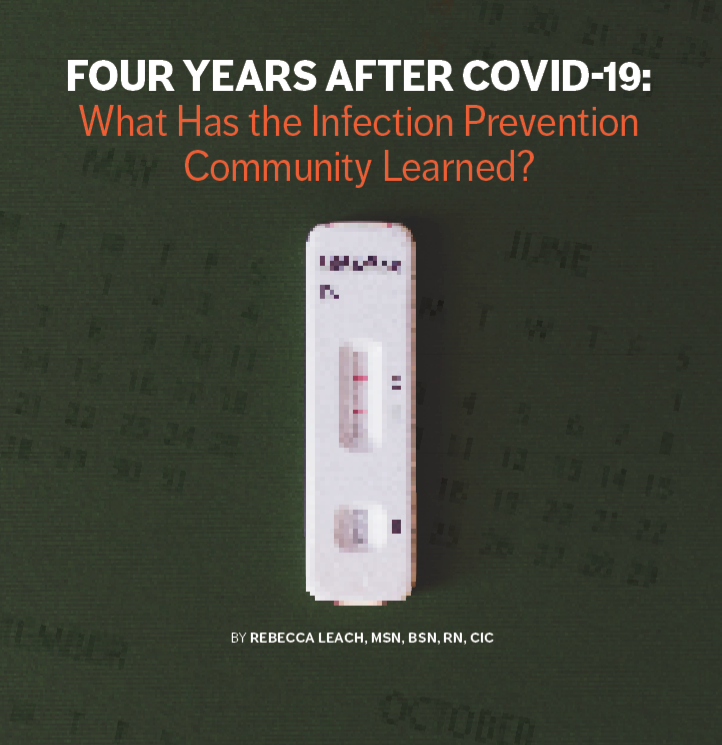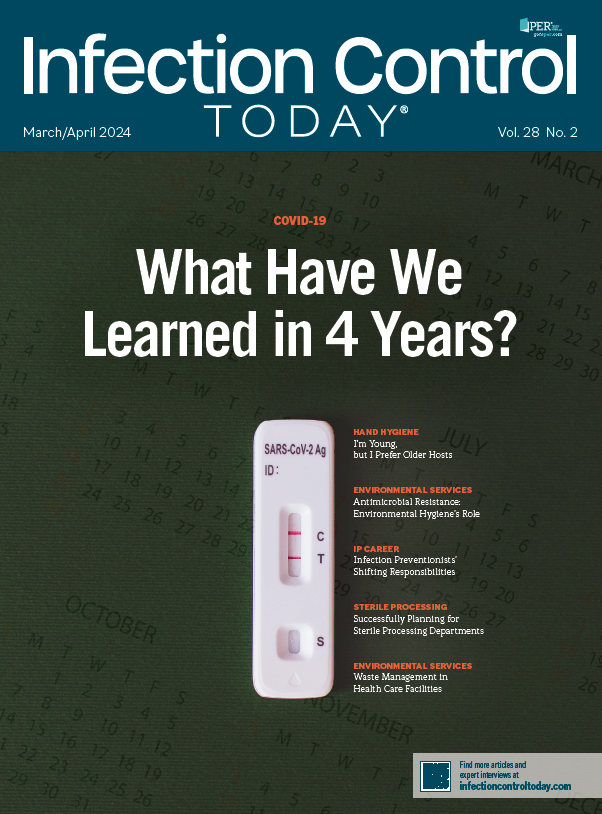Four Years After COVID-19: What Has the Infection Prevention Community Learned?
Four years ago today, March 15, 2020, the COVID-19 lockdown began, and since then, the world has undergone significant changes. It has been a terrifying experience for everyone, especially for the infection prevention community, both within and outside of the health care sector. However, a crucial question remains unanswered: What has the infection prevention community learned from this pandemic, and where does it go from here?
Four Years After COVID-19: What Has the Infection Prevention Community Learned?

It has been 4 years since COVID-19 was declared a global public health emergency in March 2020. In that time, many lessons have been learned about pandemic response and the role of infection prevention in health care. As we begin to act on those lessons, it is important to understand the impacts of the pandemic and how we can build on the momentum to elevate the profession.
Lessons learned can be classified into several broad categories. The first involves operational processes, including how organizations respond to public health emergencies, collaboration within and outside the organization, infrastructure, and resource allocation. The second involves public health in the nation and globally, including how populations are affected differently and how communication of public health interventions affect pandemic response. The last involves the impact on the field of infection prevention itself, the recognition of infection preventionists (IPs) as leaders, the threat of IP shortages, and the expansion of IPs into nontraditional fields.
Operational Processes
Before 2020, rarely were outbreaks of infectious diseases considered part of a health care organization’s emergency response plan, certainly not to the level of large-scale planning and drills. Having a strong emergency preparedness program in place should set up a facility to have the ability to respond effectively, regardless of the nature of the incident. Particularly in infectious disease emergencies, the IP and hospital epidemiologist need to have a strong role in guiding efforts.
Collaboration with public health agencies, other health care facilities, and local resources proved essential for the overall success of the response to COVID-19. Silos should not persist, as such partnerships were effective in supporting responses to include unlikely partners and can extend limited resources. Health care facilities need to be more involved in their regions’ and states’ public health efforts. As health care continues to move to ambulatory space, many lessons can be learned from local health departments on how to impact communities of care.
The pandemic highlighted the challenges of obtaining appropriate personal protective equipment (PPE) and the limitations of the types of PPE available, particularly respirators. Challenges involved with shipping from outside the country reduced availability while demand rose. Additionally, the challenges of obtaining the appropriate types of respirators for the clinical staff, continuous fit testing to adjust to the current “mask of the day,” and developing the reuse and extended-use protocols were all daily obstacles to providing safe patient care.
Based on these experiences, more companies are looking at increasing domestic production facilities and expanding partnerships with broader distributors so there are more options for shipping. Unfortunately, the costs associated with production in the country are often higher. Health care facilities are struggling with funding, especially those in the most underserved communities.
Subsidies and incentives for companies that produce medical supplies and equipment to diversify their sourcing and increase production domestically would help alleviate potential PPE shortages and the price gouging that occurs with increased demand. Similarly, health care organizations can invest in reusable respirator options to ensure supply is available for staff that can accommodate rapid implementation for response.
Hospital environments and infrastructure were pushed to their limits during the pandemic. Air handling units and negative pressure machines were updated and installed. Collaboration with facilities managers allowed for creative ways to meet negative pressure needs for COVID-19 units. However, the costs associated with renting extra equipment, modifying existing rooms, and maintaining the equipment were excessive.
Building codes currently account for adding negative pressure rooms and isolation rooms as part of architectural plans. However, this is often limited to 1 room per unit, which is typically sufficient for normal daily activities. IPs need to be involved early in design sessions to provide input into how to set up spaces so that modifications needed for pandemic or outbreak response can be accommodated and layouts of clinical areas are adaptable to changing conditions.
Masks symbolized much of the strife that IPs had to overcome during the pandemic, from the early days of homemade cloth masks to the dearth of respirators and bringing in products that may not have been considered medically sound. When and how to wear a mask and which mask was most protective all became household conversations.
The CDC recently pushed back on updated Healthcare Infection Control Practices Advisory Committee guidelines to update isolation practices, specifically focusing on the concern over lax mask-wearing recommendations.1 As these guidelines continue to be examined, science and current knowledge must lead the conversation. IPs need guidance that can be implemented with the highest level of safety for staff and patients.
National and Global Impact
During the pandemic, national public health authorities were looked to for guidance. That guidance would rapidly change as more was learned about the disease and how to prevent its spread. At the time, the CDC’s guidelines on transmission had last been updated in 2007. Droplets and aerosols were a daily discussion topic, and there continues to be much to learn about the dynamics of respiratory disease spread. It may be more complicated than prior considerations. However, the question remains: How does that impact operational clinical guidance?
National support for high-consequence disease response and biopreparedness waxes and wanes depending on leadership and world events. Consistent and supported preparedness programs and funding are essential to continuing the growth and improvements across the national health care landscape.
One example of an effort to increase the workforce for biopreparedness is the Bio-Preparedness Workforce Pilot Program, which would provide loan repayment programs for infectious disease and emergency preparedness professionals to work in underserved areas.2 Programs like this and
adequate funding for the CDC and state public health departments would establish a framework to build biopreparedness efforts.
As the scope of infection prevention expands beyond the traditional walls of acute care settings, the COVID-19 pandemic highlighted the many disparities concerning infectious diseases. Social determinants of health and health inequity are not often discussed in hospital infection prevention; however, from a public health perspective, social impacts on health have long been considered when developing programs.
The COVID-19 pandemic response highlighted that IPs are leaders in their organizations. The IP is the subject matter expert for disease transmission and understands how all the many pieces of a facility impact the patient and staff, such as air handling, environmental services, supply chain, and clinical practices.
Many infection control practices aimed at reducing health care–associated infections (HAIs) were not sustained during pandemic response. In an analysis, the CDC found significant increases in HAIs in 2021 compared with 2019.3 There are many reasons for the increase. However, the lesson to be learned is that IPs need to be innovative when resources are limited, and priorities are competing.
For example, when many departments sent staff home during the pandemic because procedural areas were closed, those staff could have been trained to perform rounding on devices and provide education on HAI prevention efforts. Additionally, working with clinical staff to help develop workflows that make patient safety efforts a part of the standard practices is essential. Being creative and inviting the bedside staff to offer ideas will also help increase buy-in and support.
Moving forward, prevention practices need to be at the forefront of daily workflows and practices to reverse the trend. Consideration must be given to how to build a sustainable practice. If another pandemic or significant event occurs, we do not want to see the same decline in patient outcomes from preventable infections.
IPs as Leaders in Infection Prevention
The pandemic emphasized that infection prevention faces similar concerns as other areas of health care regarding the aging workforce and burnout. Retention, recruitment, and resilience of the profession are at the forefront as we move forward. Additionally, increased mandatory reporting, regulatory requirements, and the field’s expansion into
nontraditional areas have increased the demand for IPs.
Unfortunately, turnover in the field is also an issue, particularly in long-term care and ambulatory spaces. A recent study found over half of long-term care facilities had IP turnover in the past 24 months.4 Similarly, there is worry about a massive retirement in the coming years, with up to 40% of active IPs reaching retirement age.4
It will be imperative for health care organizations to develop recruitment and retention plans for IPs. Because most of the professional training occurs on the job, having a broad job description that includes multiple health-related backgrounds will bring in a diverse pool of applicants. Organizations can develop rigorous and standardized training and onboarding for novice IPs, utilizing many of the resources available through professional organizations, such as the APIC Novice Roadmap for the Infection Preventionist by the Association for Professionals in Infection Control and Epidemiology).
Another example was published by a facility in Boston, Massachusetts, that developed an internal IP fellowship to increase staffing and diversity in the IP department by focusing on underrepresented racial and ethnic groups.5 This commitment from the facility was unique in that it addressed the staffing shortage and increased the diversity of the field.
As witnessed during the pandemic, health care inequity has a significant impact on patient outcomes with infectious disease. Recognition of these underlying inequities is beginning to be addressed in infection prevention. A diverse workforce can relate to the unique experiences of your patients and staff and offer innovative ideas and nontraditional approaches to long-standing issues, such as hand hygiene compliance and patient education. As the field of infection prevention continues to grow and evolve, having those unique perspectives will increase the value and positive impact on the profession.
Infection Prevention Outside of Health Care
The COVID-19 pandemic also highlighted that infection prevention concepts are applicable in many settings outside of health care. Retail, restaurants, entertainment, business, and school settings all utilized the concepts, and many employed IPs as consultants to develop and operationalize plans and practices to maintain safety while keeping the business running. This is an exciting opportunity for IPs to expand their roles beyond health care and impact public safety in nontraditional settings.
The lessons learned from the pandemic response are vast, and many will continue to shape health care, particularly infection prevention, for years to come. As a professional group, IPs need to use these challenges and barriers to improve practice, continue to shape their leadership skills, and ride the momentum to move the field forward.
REFERENCES
1. Kavanagh K. CDC sends back proposals to HICPAC on pathogen spread in health care revision. Infection Control Today. January 24, 2024. Accessed February 10, 2024. https://www.infectioncontroltoday.com/view/cdc-sends-back-proposals-hicpac-pathogen-spread-health-care-revision
2. Bio-Preparedness Workforce Pilot Program implementation update. Infectious Disease Society of America. January 2023. Accessed February 10, 2024. https://www.idsociety.org/policy--advocacy/bio-preparedness-workforce-pilot/
3. COVID-19 impact on HAIs. CDC. Updated June 10, 2022. Accessed February 9, 2024. https://www.cdc.gov/hai/data/portal/covid-impact-hai.html
4. Gilmartin H, Smathers S, Reese SM. Infection preventionist and professional development strategies: insights from a national survey. Am J Infect Control. 2021;49(7):960-962. doi:10.1016/j.ajic.2021.04.083
5. Nelson AL, Steiner J, Hanley D, et al. Revitalizing the infection prevention workforce with a fellowship for underrepresented groups. Infect Control Hosp Epidemiol. 2023;44(12):2050-2051. doi:10.1017/ice.2023.3

Uncovering a Hidden Risk: Alcohol Use Disorder Significantly Increases C difficile Infection Rates
April 10th 2025A groundbreaking study reveals a strong connection between alcohol use disorder and increased risk for Clostridioides difficile infection, challenging traditional assumptions and calling for enhanced infection prevention protocols.
Bridging the Gap: Operating Room and Central Processing Unite to Improve Surgical Efficiency
April 8th 2025Communication breakdowns between the operating room and central processing led to delays and frustration—until collaboration, cross-training, and shared goals turned metrics around and strengthened teamwork.